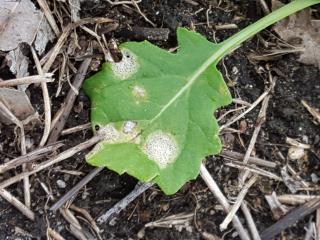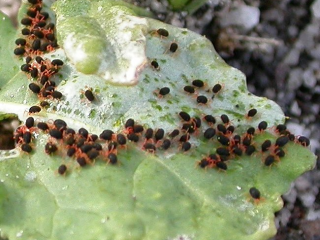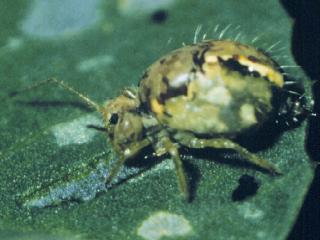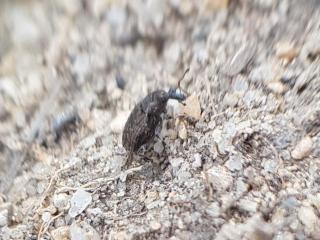Growers and consultants are urged to check for lucerne flea and mites
- Capel
- Boyanup
An agronomist reports finding redlegged earth mites (RLEM) causing low levels of feeding damage to pastures around Capel and Boyanup. The pastures were dry sown and germinated following the first rain for the season. As a result, the pastures got a head start on the mites and were well established before the RLEM emerged following the more recent cooler wet weather.
The substantial rainfall and low temperatures experienced recently across the state is expected to have triggered lucerne flea and RLEM hatchings.
Due to the delayed start to the season there are some canola and cereal crops that are just emerging, coinciding with lucerne flea and mite hatchings, and they will be susceptible to feeding damage.
The lucerne flea is a Collembolan or 'springtail'. Adult lucerne flea are approximately 3mm in size and green-yellow in colour. It attacks a range of crops and pastures, causing characteristic ‘windowing’ of leaves. They work up the plants from ground level, eating tissue from the underside of the foliage. Loamy and clay soils are known to support higher populations of lucerne flea than soils with low clay/silt content because the fine clay is required for reproduction.
RLEM are a sap-sucking pest of crops and pastures. Adults are 1mm long with a black body and eight red-orange legs. RLEM have a cold temperature requirement (generally seven days below 20°C average daytime temperatures) before the eggs are triggered to hatch. RLEMs do co-exist with blue oat mites so make sure you correctly identify what mites you are finding. Blue oat mites look similar but have a red dot on their back.
For earth mites, correct identification is critical for effective control, as different species can vary in their susceptibility to certain insecticide groups, either naturally or through insecticide resistance. You can report and confirm the identity of mites by using the PestFax Reporter app.
Management of lucerne flea and RLEM
Insecticides will not kill RLEM eggs so it should not be assumed that a pre-sowing insecticide application has killed all mites that could be present during crop germination.
Lucerne flea have a high natural tolerance to synthetic pyrethroids so avoid insecticides from this group.
For more insecticide information refer to DPIRD’s 2018 Autumn/Winter Insecticide Guide.
RLEM insecticide resistance and 2018 resistance surveys
RLEM surveys for resistance will again be undertaken in 2018. Western Australia is now not the only state to have RLEM that are resistant. Three populations of RLEM have been found in South Australia which are resistant to commonly applied insecticides including synthetic pyrethroids (SPs) (Group 2A) and the organophosphates (Group 1B) omethoate.
In WA, we have detected RLEM populations with high levels of resistance to SPs, including bifenthrin and alpha-cypermethrin and the organophosphates (Group 1B) omethoate and chlorpyrifos. Detections of resistance are becoming more common across the WA grainbelt.
Growers and consultants are urged to apply integrated pest management (IPM) strategies when managing RLEM. These strategies include; identifying mites, rotating different chemical groups and reserving co-formulations or chemical mixtures only for situations where damaging levels of RLEM and other insect pests are present. For more IPM information see DPIRD’s Prevent redlegged earth mite resistance page.
If you are noticing that RLEM are surviving registered rates of insecticide treatments or are causing damage to germinating crops consider contact Alan Lord or Svetlana Micic to arrange for resistance testing.
To check out previous mite activity this season refer to the 2018 PestFax Issue 5 article Insect pest activity this week.
For more information about diagnosing and managing lucerne flea and different mites refer to the departments;
- Diagnosing lucerne flea
- Diagnosing bryobia mite
- Diagnosing balaustium mite
- Diagnosing blue oat mite
- Diagnosing redlegged earth mite pages.
For more insect information contact Svetlana Micic, Research Officer, Albany on +61 (0)8 9892 8591 or Dustin Severtson, Development Officer, Northam on +61 (0)8 9690 2160 or Alan Lord, Technical Officer, South Perth on +61 (0)8 9368 3758.
Desiantha weevils and rutherglen bugs are in canola
- Wandering
Farmer John Parsons has found desiantha weevils (also known as spotted vegetable weevils) and rutherglen bugs in his Bonito canola crop near Wandering. The canola plants ranged in growth stage from cotyledons to the four leaf stage. The older canola plants had visible feeding damage but new cotyledons were not damaged. The farmer was monitoring the crop to decide if insecticide needed to be sprayed.
Desiantha weevil adults are mottled grey-black in colour with grey flecks on the abdomen and have the typical elongated weevil snout. They grow up to 7mm long and are flightless. Larvae are white, legless grubs with orange-brown heads and grow to 8mm in length.
Desiantha weevil larvae attack cereals at the seedling and tillering stages. They feed underground on germinating seeds, and bore into the stems of seedlings and tillers, often killing plants or resulting in abnormal and stunted growth. In contrast, canola is mostly damaged by adults. They chew cotyledons, leaves and stems of canola plants and may eat small plants down to ground level.
Rutherglen bug adults are 4mm long, have clear wings folded flat on the back, are grey-brown-black in colour and are very mobile. Rutherglen nymphs have a pear-shaped, red-brown body. Swarms of the bugs, nymphs and adults, often move out from under weed plants when they are disturbed. Damage from the rutherglen bugs is similar to mite sucking in that seedlings will become stunted, discoloured and distorted. Rutherglen bugs do most damage to moisture stressed plants.
Rutherglen bugs prefer warm dry conditions and should become inactive and die out with prolonged cold and wet winter weather patterns.
For more information on these insects refer to the department’s Diagnosing weevils in canola and Diagnosing rutherglen bug pages.
For more insect information contact Svetlana Micic, Research Officer, Albany on +61 (0)8 9892 8591 or Dustin Severtson, Development Officer, Northam on +61 (0)8 9690 2160.
Latest blackleg sporacle forecast is predicting high blackleg risk in southern areas

The department’s latest blackleg forecast, which is current to 5 June 2018, is predicting that the risk of blackleg is currently high in most of the southern region canola crops.
The model is currently predicting that major spore releases are likely to coincide with canola seedling establishment for the districts of; Esperance Downs, Scaddan, Munglinup, Jerramungup, Mount Barker, Darkan, Katanning, Narrogin and Williams.
Blackleg spores are already releasing in Mount Barker and Esperance Downs.
Canola pathologist Ravjit Khangura (DPIRD) encourages growers in these areas to assess the risk of blackleg in their current canola crop based upon the resistant rating of their planted variety, distance to previous year’s canola residues and whether they have applied an upfront fungicide application.
Ravjit says seasonal conditions have been unique this season and due to the late break most of the dry sown crops will be emerging now. Consequently, these crops are at a high risk of intercepting the spore showers at the seedling susceptible stage of the crop. Unprotected crops in medium to high risk situations are likely to be benefited from foliar fungicide application.
In some central and eastern districts (such as Moora, Lake Grace and Lake King) the risk of blackleg is currently predicted to be medium. Whereas, in some far northern, central and eastern areas (including Eradu, Mullewa, Wongan Hills and Merredin), the current risk of blackleg is predicted to be low.
Please visit the department’s Canola blackleg spore maturity forecast for Western Australia to find out for the forecast for other districts.
The blackleg spore shower risk will change each week as the season progresses depending upon the weather conditions in the coming weeks, therefore, growers are urged to check the weekly updates.
The recently released BlacklegCM app can be downloaded onto tablets from the apple store or Google Play and used to support decisions on fungicide management options. Developer of the app Art Diggle (DPIRD) says that the app allows the user to enter information specific to their paddocks and circumstances. For more information refer to the department's BlacklegCM page.
For further details on blackleg management and current blackleg ratings refer to GRDC’s Blackleg Management Guide (2018 autumn variety ratings).
For more information about blackleg in canola and the blackleg sporacle model contact Ravjit Khangura, Research Officer, South Perth on +61 (0)8 9368 3374 or Kawsar Salam, Research Officer, South Perth on +61 (0)8 9368 3104.




